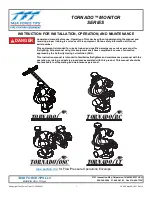
Before Starting Source or Measurement
3-5
IM CA150E
1
2
3
4
5
6
7
8
9
10
11
12
App
3.2.3 Using an NiMH Battery Pack
Charging type
NiMH (nickel hydrogen) battery (optional): Model: 94015
Specifications
Voltage: 7.2 V
Capacity: 2100 mAh (typ.), 1900 mAh (min.)
Number of times can be charged (life cycle): Approx. 300
times (varies depending on the operating environment)
Be sure to observe the following warnings on handling the NiMH battery.
WARNING
• The electrolyte solution contained in the NiMH battery pack is alkaline.
If it comes into contact with any clothing or skin due to a leakage from or
rupture in the battery pack, the clothing or skin may be damaged.
In particular, if the solution gets into an eye, it may cause loss of eyesight.
In such a case, do not rub the affected eye, but thoroughly wash it
immediately with clean water. Then see a doctor quickly for treatment.
• When replacing the NiMH battery pack, always turn off the power switch of
the instrument and disconnect the AC adapter power cord from the outlet
to avoid possible danger such as a short in the electric circuit or electrical
shock.
• Do not use any battery pack other than YOKOGAWA’s NiMH battery pack
(model: 94015).
• Do not leave the NiMH battery pack in strong direct sunlight, inside a vehicle
under the hot sun, or near a fire, otherwise it may result in a solution leakage
or deterioration in the performance and/or life.
• Do not disassemble or modify the NiMH battery pack, otherwise the protective
features of the battery pack may be damaged, resulting in heating up or rupture.
• Do not short the NiMH battery as this may cause burns due to the battery pack
heating up.
• Do not dispose of the battery pack in a fire or apply heat to it, otherwise there
is a risk that it will rupture or its electrolyte solution will scatter.
• Do not apply excessive shock to the battery pack, for example, by throwing it.
Doing so may cause solution leakage, battery pack heating, or rupture.
• Do not use a defective battery pack, such as one leaking solution, deformed,
discolored, or showing any other abnormality.
• Avoid any metal coming into contact with the battery pack when carrying it,
as there is a danger of a short.
• Do not immerse the battery pack in water or make it wet. Otherwise, it may
heat up or rust, as well as lead to a loss of functions.
If the battery pack will not be used for a prolonged period, remove it from
the instrument and store it in the following environment.
Storage period of 1 year or less:
Temperature of -20 to 35°C (in locations with low humidity)
Storage period of 3 months or less:
Temperature of -20 to 45°C (in locationswith low humidity)
3.2 Connecting a Power Supply
















































